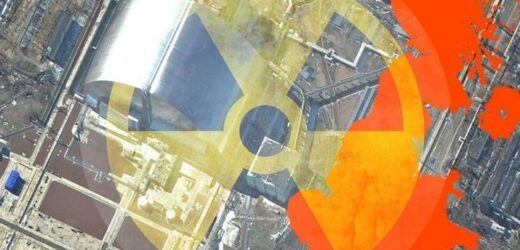Russia could use Chernobyl to 'blackmail' Europe says expert
We use your sign-up to provide content in ways you’ve consented to and to improve our understanding of you. This may include adverts from us and 3rd parties based on our understanding. You can unsubscribe at any time. More info
Since Russian President Vladimir Putin invaded Ukraine, Russian forces have sparked panic across Europe by gaining access to the Chernobyl power plant by force. Last week, the Ukrainian Defence Intelligence alleged that Putin has ordered the preparation of a “terrorist attack” at Chernobyl with an intention to create a “man-made catastrophe”. Since then, fears have grown that Russian forces may bomb other power stations in Ukraine, which could create a devastating nuclear fallout that afftecting the whole of Europe.
Some have even posed the question of whether history could repeat itself and see the UK impacted.
But speaking to Express.co.uk, Harry Eccles, Professor of Nuclear Materials and Director at the Research Centre for Smart Materials at the University of Central Lancashire (UCLan), quashed any fears Britons may have.
He said: “In the case of the Chernobyl accident in 1986, radiation leaked from the damaged reactor and entered the atmosphere.
“This was due to the intense heat generated from the meltdown, when very high temperatures of over 1,000C were created within the damaged reactor.
“Under circumstances like the one at Chernobyl, some radioisotopes, such as radioactive caesium and strontium, can become volatile.”


Prof Eccles warned that once volatile and in the atmosphere, these radioisotopes can be carried by prevailing wind currents to other countries up to around 2,000 miles away, and then eventually precipitate and fall as rain.
This is what happened during the 986 Chernobyl disaster.
In Wales, nearly 10,000 farms and four million sheep were put under government restrictions and the impact of Chernobyl was felt for decades.
But a similar situation would thankfully not be repeated today, according to the expert.
Prof Eccles continued: “The design of nuclear reactors and their operation must comply with stringent safety checks by national and international bodies.

“The Chernobyl disaster was created by events within the reactor. Reactors today are designed differently and safer and more robust.
“Therefore, in the current world climate, we are considering a different scenario – an explosive device hitting a reactor.”
Ukraine currently has 15 Russian made nuclear reactors at four sites,
Prof Eccles assured that these reactors are constructed with several layers of protection to prevent any radioactivity from entering the environment.
DON’T MISS:
UK to avoid Putin’s EU energy wrath as huge new gas field found [REVEAL]
EU civil war: France and Spain lock horns over new pipeline [INSIGHT]
Putin blinks first: Bumper gas supplies sent to EU [SPOTLIGHT]


He said: “These protective layers include the reactor dome, which is constructed of reinforced concrete of at least 1.5m thickness.
“Moreover, the fuel itself is encased in a thick steel pressure vessel.
“Therefore, in the case of an explosive device hitting the reactor, it is highly unlikely that radioactivity would be released.”
Prof Eccles also believed that if there was a radioactive leak from a damaged Ukraine, it would be highly unlikely that it reaches the UK.
He said: “In the event of a radioactive leak from a damaged reactor in Ukraine, the radioactivity would have to travel nearly 2000 miles before it reached the UK shoreline.
“Most of the activity could be detected and deposited long before it reached the UK.”
Source: Read Full Article


